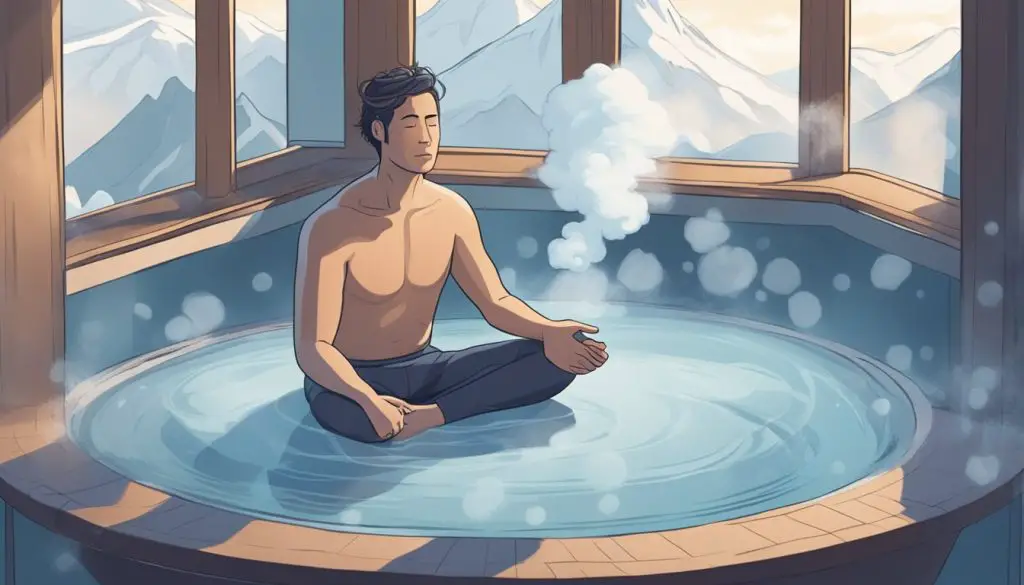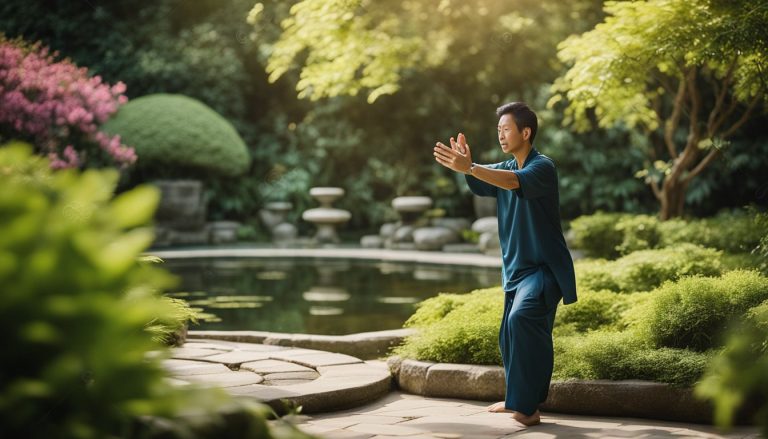Can You Meditate in an Ice Bath? Exploring Chilly Mindfulness Practices
Introducing an unconventional twist to meditation practices, the concept of meditating in an ice bath offers a fusion of mindfulness and cold exposure therapy.
Traditionally, meditation involves creating an environment of warmth and comfort to help the mind and body relax. However, proponents of cold therapy suggest that ice baths can enhance mental fortitude and encourage a deeper state of focus, which are essential components of meditation.
Merging these practices, individuals can challenge their limits, both physically and mentally, to potentially reach new depths in their meditative journey.

The immediate question that arises when considering meditation in an ice bath is whether the shock of cold water is an aid or a hindrance to achieving a meditative state.
Scientific research indicates that cold exposure, akin to the cold pressor test, can elicit acute pain responses, which may seem counterintuitive to meditation’s goal of tranquility.
Yet, there is an emerging interest in using stress-inducing environments to reinforce mindfulness and control.
By redirecting attention away from discomfort and focusing on one’s breath or a mantra, ice baths could potentially amplify the benefits of traditional meditation through heightened sensory awareness and resilience building.
Key Points
- Meditating in an ice bath is a blend of mindfulness and cold exposure therapy.
- Ice baths may seem counterintuitive to meditation but can enhance focus under stress.
- This practice challenges conventional meditation, fostering heightened awareness and resilience.
Table of Contents
Understanding Ice Baths and Cold Therapy
I’ve discovered that ice baths are part of a broader method known as cold therapy, which involves exposing the body to cold temperatures to elicit physiological responses.
Let’s dive deeper into what this practice entails, its benefits and potential risks, and its importance in the realm of athletic recovery.
The Science of Cold Exposure
When I immerse myself in an ice bath or engage in any other form of cold water immersion, my body undergoes a process called vasoconstriction.
This is where my blood vessels constrict, reducing blood flow to my extremities. This natural response is my body’s way of preserving heat by diverting blood away from my skin’s surface towards my core.
Health Benefits and Risks
Health Benefits:
- May reduce muscle inflammation and soreness post-exercise
- Could potentially enhance my nervous system’s resilience
Risks:
- Hypothermia if exposed to extreme cold for too long
- I must be careful with the duration and frequency to avoid skin and nerve damage
The Role of Ice Baths in Athletic Recovery
Ice baths, a component of cryotherapy, have been integrated into sports medicine routines for athletes like me to speed up recovery.
The rationale is that the cold water helps to reduce muscle soreness after intense activities. However, the effectiveness can vary, and it’s critical I balance its use with other recovery methods to optimize my athletic performance without compromising my health.
The Intersection of Meditation and Ice Baths
Exploring the uncharted waters of combining the tranquil practice of meditation with the invigorating challenge of ice baths, I’ve found that two distinct but complementary angles warrant a closer look.
Meditation Techniques in Cold Environments
When meditating in the bracing cold of an ice bath, the usual methodologies of mindfulness and focus come into play, but I’ve learned they are adapted to withstand the initial shock of the cold.
Breathing exercises become a critical component, as a steady, controlled breath can help manage the body’s stress response to extreme temperatures.
A modified version of the Wim Hof Method, involving deep, rhythmical breaths, can prove to be especially effective in maintaining focus and equanimity in the face of the cold shock response.
Physiological Effects of Combining Meditation with Cold Exposure
The marriage of meditation and cold water therapy intrigues me for its physiological implications.
During this practice, I’ve experienced firsthand how the cold exposure can trigger the body’s survival mechanisms, resulting in heightened sensory awareness.
My mind must remain sharply focused to keep my breathing from becoming erratic.
The cold environment stimulates the vagus nerve, which, when combined with meditation, enhances the body’s relaxation response after the initial stress response.
This has contributed to a decrease in my stress levels and an improvement in stress resilience over time.
Practical Guide to Meditating in an Ice Bath

In exploring the union of cold exposure and meditation, I’m keen to share how these practices can intertwine. Below, I’ll walk you through how to safely meditate in an ice bath, step by step.
Essential Safety Considerations
Before I submerge myself into the icy water, safety is my top priority. Here’s what I keep in mind:
- Consult a healthcare provider: I make sure to talk to my healthcare provider, especially if I have conditions affecting blood pressure, heart rate, or skin.
- Preparation: I prepare a thermometer to monitor the water temperature, avoiding extreme cold that might lead to hypothermia.
- Time limit: I limit my time in the ice bath to prevent core body temperature from dropping too low.
- Supervision: I never do this alone. Having someone nearby ensures I have help if my body responds negatively.
Step-by-Step Process
When meditating in an ice bath, here is the process I follow:
- Set Up: I fill the bath with ice and water, checking the temperature is safe for human submersion, ideally between 50-59°F (10-15°C).
- Acclimation: Gradually, I let my feet, legs, and then the rest of my body acclimate to prevent shock to my system.
- Breath Control: As I enter the bath, I focus on slow and controlled breathing to manage my heart rate and blood pressure.
- Positioning: I find a comfortable seated position to ensure my skin is evenly exposed and there’s no undue pressure on any one part.
- Meditation Practice: Once settled, I close my eyes and begin my meditative practice, focusing on presence and awareness.
Monitoring Health and Responses
Staying attuned to my body’s signals is essential:
- Thermoregulation: I pay close attention to shivering or numbness, signs that my core body temperature may be dropping.
- Physical Responses: I monitor for signs of constriction or swelling, as these can indicate my body’s reaction to the cold.
- Aftercare: After exiting the bath, I gently warm myself to aid in the recovery process, ensuring I don’t heat up too quickly and disrupt my body’s adaptation.
- Self-Assessment: Post-meditation, I assess how I feel; did it improve my sleep, or did I feel invigorated? This helps me decide how to incorporate ice baths into my routine.
Frequently Asked Questions
In exploring the unique blend of ice baths and meditation, these FAQs aim to provide keen insights based on the effect of cold exposure on meditative practices.
How should I prepare mentally for an ice bath combined with meditation?
I find that starting with deep breathing exercises helps in preparing my mind and body for the shock of cold water. Mental fortitude and setting a clear intention for the session are key components of my preparation.
What are the benefits of combining meditation with an ice bath for mental health?
Combining cold exposure with meditation often enhances my mental clarity and stress resilience. It has been suggested that such practices can stimulate a positive stress response, potentially leading to improved mood and reduced anxiety.
Can an ice bath be too cold for effective meditation practice?
Definitely, there is a threshold where an ice bath can be counterproductive for my meditation. Safety should be my main concern as extremely cold temperatures can overwhelm my body, making it difficult to maintain focus or relaxation.
Is there an optimal time of day to meditate while taking an ice bath?
My personal preference leans towards morning sessions, as they invigorate my senses and start my day with a fresh perspective. However, the best time is ultimately when I feel most prepared and undisturbed for such an invigorating practice.
What are the physical and mental effects to expect from meditating in cold water?
Physically, I notice an increased heart rate and faster breathing initially, but these tend to stabilize as I deepen my meditation. Mentally, I experience a heightened state of alertness and often a profound sense of calmness after I’ve adapted to the cold.
Should you meditate before entering an ice bath or is it better to meditate while submerged in the cold?
I prefer to begin meditating before entering the ice bath to center my thoughts and improve my focus. Then, I continue meditating while I’m submerged. This approach helps me manage the initial shock of the cold and maintain a meditative state throughout the experience.







